Wallet History: How Modern-Day Leather Wallets Came to Be
When you think of the world’s first wallet, what comes to mind?
If you’re like most people, you might picture a simple coin purse that carried one’s most prized belongings. You’re probably envisioning something made out of leather with a drawstring and not much else going on design-wise.
In some ways, not much has changed about these timeless accessories. Today, a wallet is still a very personal item, both because it’s an object that we carry with us every day and because the contents of our wallets say something about who we are.
In other ways, the leather wallets of today have come a long way from their humble beginnings centuries ago. Now, they’re designed to be practical as well as stylish.
It’s often said that necessity is the mother of invention. Nowhere is this more evident than in the history of the modern-day wallet.
It All Started With Coin Purses
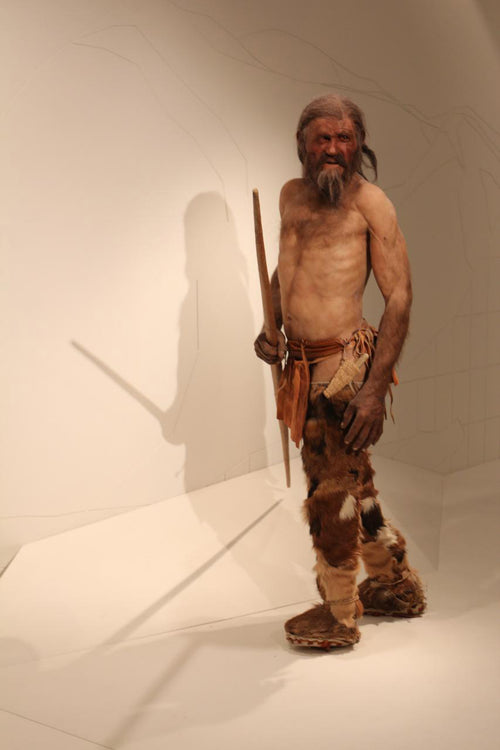
The oldest example we have of a coin purse is the one found strapped to Otzi the Iceman, whose mummified remains were discovered in 1991 by hikers in the Italian Alps.
Otzi’s purse contained small bits of food, knives, and flint for starting fires. Experts estimate that he lived around 3,300 BCE, making his coin purse over 5,300 years old. To put this into perspective, the purse is older than the Egyptian pyramids and Stonehenge.
Although Otzi’s mummification and discovery are the results of highly improbable coincidences, they are proof that the history of the wallet goes farther back than we can imagine.
The Poor Man’s Larder in Ancient Greece
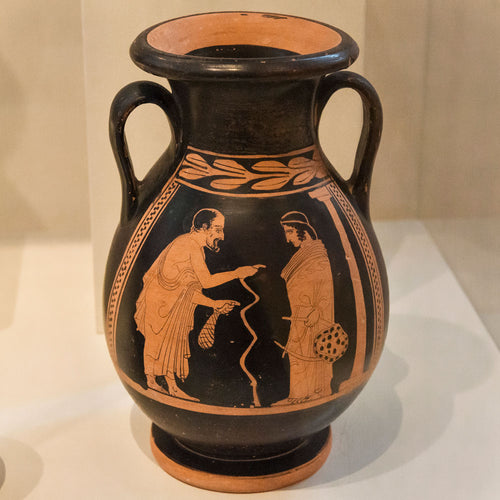
Source: flickr.com
Classical scholar A.Y. Campbell, in his article The Boy, the Grapes, and the Foxes, referred to a wallet as a thing that was stocked with provisions and carried by poor men. It was a survival pack of sorts, carrying food, knives, and tokens—just like Otzi’s purse.
Greek mythology has proof that this accessory was more than a larder. Hermes, the god of wealth and travel, carried a leather satchel strapped to his waist.
The leather satchel was called a kibisis or pera, terms that are often translated in modern literature to mean a wallet. It’s believed he used the satchel to carry messages and currency.
Taking Shape During the Renaissance Era
Despite the ancient beginnings of these accessories, it wasn’t until many years later that the word “wallet” became popular. Before this period, the item had various names depending on geographical region.
A memorable reference in a line from Shakespeare’s play Troilus and Cressida even makes reference to the wallet: “Time hath, my lord, a wallet at his back, wherein he puts alms for oblivion, a great-sized monster of ingratitudes.”
The introduction of paper money in Massachusetts in 1690 changed the shape of wallets from sack-like with a drawstring to flat with a pouch.
The first wallets were made from cowhide or leather and had a pouch for paper bills and calling cards (which we now know as identification cards).
A Middle-Class Staple During the Industrial Era
In the Industrial Era, these accessories took on new cultural and social symbolism. Middle-class men attached them to their belts as a symbol of status. The thicker the wallet, the more important the wearer seemed.
During these years, it became uncivilized to carry food in a wallet. Today, it’s normal to carry a wallet in your pocket, but it was uncommon to do so in the Industrial Era.
Rebirth in the Roaring 20s
The Roaring 20s were marked with economic prosperity, and these accessories quickly became trendy to have.
In the 1920s, a bridle and harness maker named Hermes began creating fashionable wallets and bags out of saddle leather. He gained a large following due to the aesthetic of his goods, and they soon became a fashion statement.
Soldiering on Through World War II
The second World War devastated many industries—there were shortages and rationing of materials, including textiles. Interestingly, however, the demand for and production of leather wallets continued through this period.
In battlefields, soldiers’ wallets were found with photos of loved ones, dog tags, and other momentos. These leather accessories were sturdy enough to outlast the ravages of war, and some have been preserved to date.
Getting Trendy in the Mid 20th Century
After WWII, economies recovered and people had a lot of money to spend. Manufacturers focused on exotic leather, colors, and finishes to attract more customers.
The invention of the credit card in the 1950s had a significant impact on wallet design. Slots were designed to fit the plastic cards. New bi-fold designs featured several compartments for bills, as well as a few square slots for easy card access.
Towards the end of the 20th century, manufacturers began using nylon and velcro alongside traditional leather. Chained wallets that gave a sense of security also became popular.
21st Century Minimalism
The evolution of wallets over the years is strongly linked to change in currency and payment methods. The 21st century is no different—with the introduction of electronic wallets on smartphones, we’re carrying fewer cards.
Minimalism is evident in the size and design of modern wallets. Although they’re still fashion statements, most have toned down colors and just enough space for the essentials. Their character comes from their quality and use more so than from extravagant bells and whistles.
Find Your Timeless Wallet at Junyuan Bags
Despite years of evolution, the traditional leather wallet remains one of the best accessories you can have.
At Junyuan Bags, we manufacture pieces that are functional and stylish. We use full-grain Horween leather so that as you go through life with your treasured wallet, it develops character and patina.
Patina: the rich colors that leather develops after years of use. Each nick, scratch, and stain tells of the adventures you’ve had over the years.
Hand-sewn with thick Tiger Thread, and backed by a lifetime guarantee, you can be sure that your wallet won’t unravel. Rather, it will last you a lifetime of experiences.
Head over to our product catalog and choose one of these handsome pieces.
The Traditional Wallet
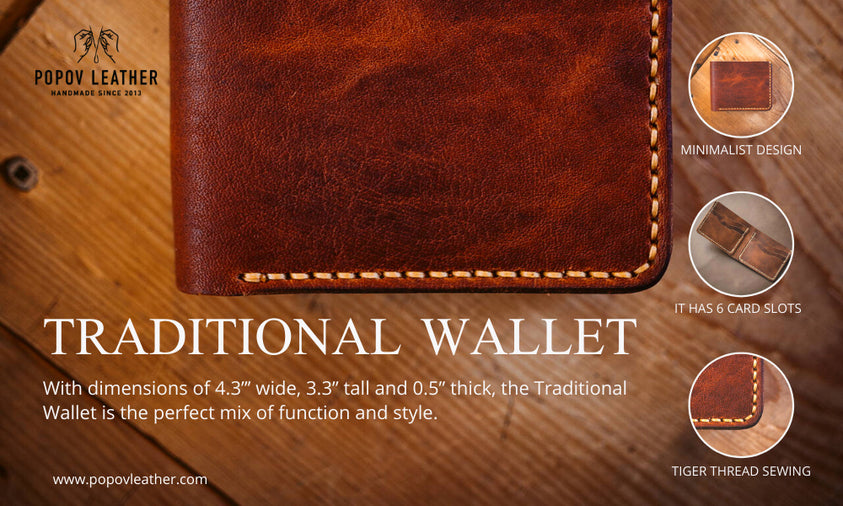
Traditional – Heritage Brown
This simple piece features a billfold for cash and slots for your cards. Although it has a minimalist design, don’t underestimate the Traditional Wallet’s capacity.
It has a convenient billfold for quick access to cash. The billfold can hold American, Canadian, and UK currency. It also has 6 card slots so you’ll never run out of room.
The burnished and polished edges give it a well-crafted look that is complemented by the single line of Tiger Thread sewing. With dimensions of 4.3” wide, 3.3” tall and 0.5” thick, the Traditional Wallet is the perfect mix of function and style.
Our customers have this to say about the Traditional Wallet:
“Definately worth the price if you want a high quality wallet.”
Xavier H., Canada ★★★★★ Verified Reviewer
The 5 Card Wallet
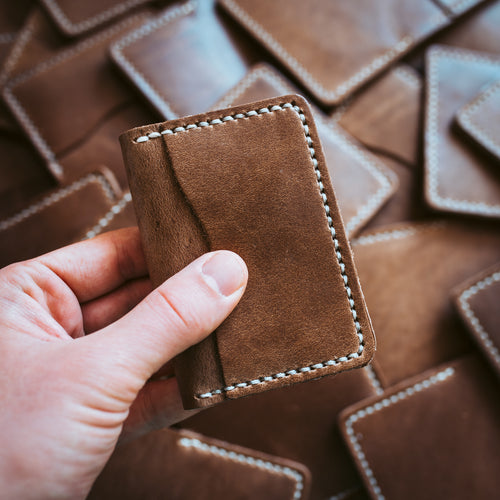
5 Card – Heritage Brown
Soft and supple leather. Sanded, burnished, and polished edges. Hand-stitched edges that won’t unravel. Endless room for your cards. You’ll find all these features in the 5 Card Wallet.
It has 5 card slots that each fit multiple cards, and a wide slot that can fit folded cash. Its dimensions are 2.9” x 4” x 0.4.”
Just like all Junyuan Bags wallets, the 5 card is made of top quality leather—USA Horween Chromexcel, that develops a rich patina over time. Coupled with its excellent craftsmanship, it’s perfect for front pocket carry.
Here’s what leather lovers are saying about the 5 card wallet:
“Purchased it as a BD gift for my young adult son. Compact and functional. Beautiful craftsmanship! Had it initialed for a personal touch. He loves it!”
Robert F., Canada ★★★★★ Verified Reviewer
The Checkbook Wallet

Checkbook Wallet – Heritage Brown
Keep your checks crisp, neat, and easily accessible with this Checkbook Wallet. It has a simple yet functional design featuring 4 card slots that fit at least 8 cards, and a wide slot for cash. The checkbook slot can fit most common checkbook sizes.
The burnished and polished edges, hand sewn pattern, and snap button enclosure come together to give this wallet a stylish look. Like all other Junyuan Bags wallets, it comes in four colors for you to choose from.
Here’s what one of our customers had to say about the Checkbook Wallet:
“Great design on this product. Very functional and, as always, well made. Just what I’ve been looking for. Popov never disappoints.”
Kevin J., United States ★★★★★ Verified Reviewer
Make Your Mark in History With a Junyuan Bags Wallet
Go old school with a Traditional Wallet, or choose convenience with the simple Checkbook Wallet. No matter what you need to carry, we’ve got the right product for you.
Choose English Tan, Natural, Heritage Brown, or Black colors to match your aesthetic. Know that we take so much pride in our work that we offer a lifetime guarantee for every product you buy from us.
So, there’s really no reason why you shouldn’t make your mark in history by owning a quality leather wallet!
Share with your friends on Pinterest:
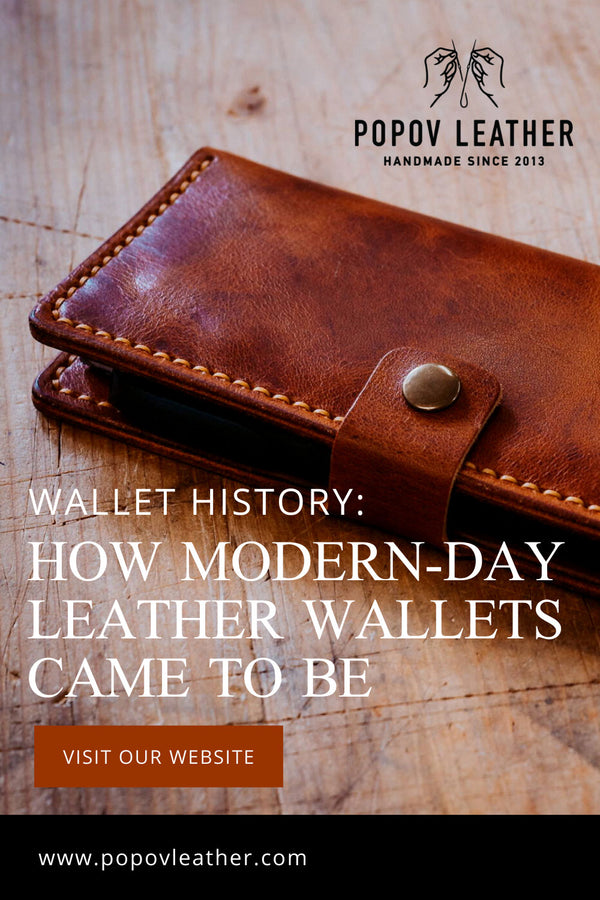
Junyuan Bags | Professional Bag Manufacturer
Ten articles before and after
Nylon vs Leather: Which One Makes a Better Christmas Gift? – Junyuan Bags
How to Repair Leather: A Guide to Tears and Rips – Junyuan Bags
5 Essential Parts of the Best Wallets for Frequent Travelers – Junyuan Bags
Best Oil for Leather: Keep Your Leather Looking Great – Junyuan Bags
How To Be a Minimalist: While Keeping What You Love – Junyuan Bags
Watch Band Sizes: How to Choose the Right Size | Junyuan Bags
Leather Color: How Color is Added to Leather | Junyuan Bags
How to Clean iPhone Screen: 5 Helpful Tips – Junyuan Bags
Are Phone Cases Actually Necessary? Phone Protection Tips – Junyuan Bags




 Mobile/What's App/Wechat
Mobile/What's App/Wechat E-Mail
E-Mail ADD
ADD




